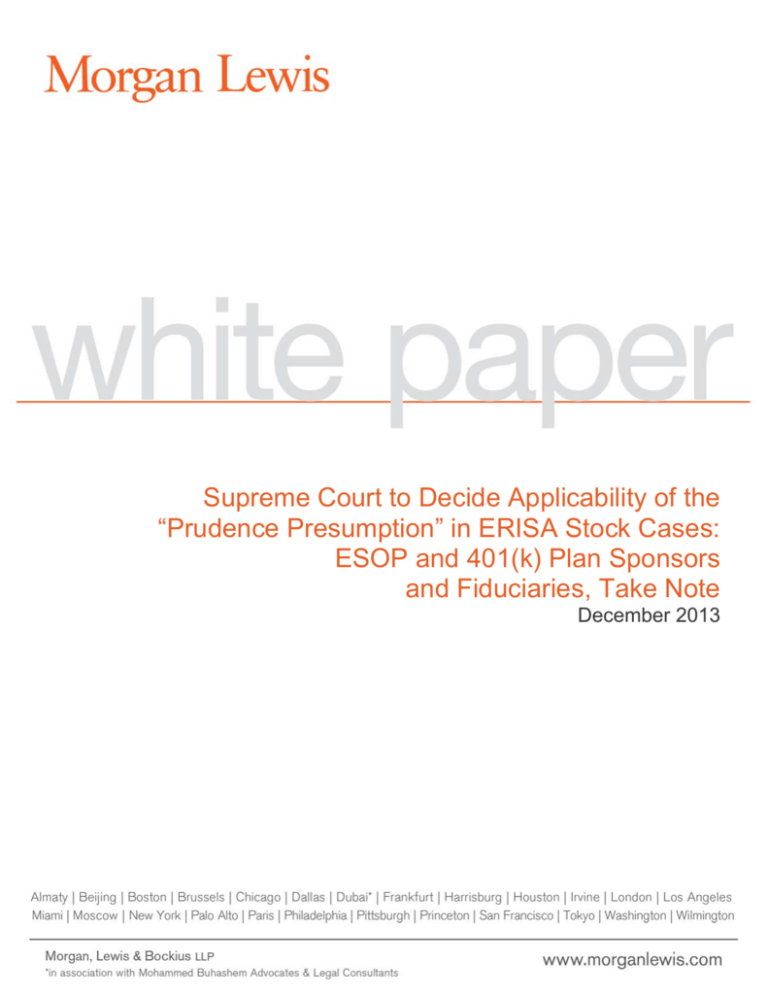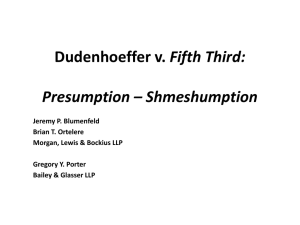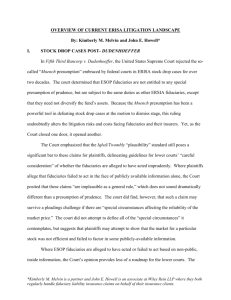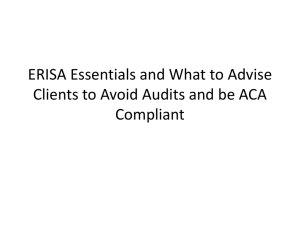
Supreme Court to Decide Applicability of the
“Prudence Presumption” in ERISA Stock Cases:
ESOP and 401(k) Plan Sponsors
and Fiduciaries, Take Note
December 2013
www.morganlewis.com 1 © 2013 Morgan, Lewis & Bockius LLP
Introduction
In Fifth Third Bancorp v. Dudenhoeffer,1 the U.S. Supreme Court will decide whether investments in employer
stock are entitled to a “prudence presumption” under the Employee Retirement Income Security Act (ERISA) and,
if so, whether that presumption should apply at the pleadings stage of an ERISA lawsuit. The outcome of the
Court’s ruling will have important implications for employee stock ownership plans (ESOPs)—which, by their
nature, are designed to invest primarily in employer stock—as well as other ERISA-eligible individual account
plans (EIAPs), such as 401(k) plans that offer employer stock as an option on the menu of investment funds.
ERISA “Stock Drop” Claims
To date, more than 200 ERISA employer “stock drop” class action lawsuits have been filed alleging that plan
fiduciaries breached their ERISA duties of prudence and loyalty by allowing participants to invest their plan
accounts in employer stock. Following the Enron/WorldCom scandals of 2001 to 2002 and the more recent global
financial crisis, there has been a significant uptick in the filing of these complaints. In a number of instances,
ERISA stock-drop complaints have been filed as tagalongs to securities fraud complaints against companies and
their executives.
Stock-drop cases generally boil down to two substantive claims: (1) a “prudence” claim, alleging that employer
stock became an imprudent investment alternative because of circumstances adversely affecting the company
and that the plan fiduciaries breached their fiduciary duties by continuing to allow investments in the stock; and/or
(2) a misrepresentation/omission claim, alleging that the plan fiduciaries knew or should have known about the
circumstances adversely affecting the company and that they breached their fiduciary duties by affirmatively
misleading or failing to warn participants of the risks. A common theme in these cases is that the fiduciaries
allegedly should have sold off the plan’s holdings in the company’s stock based on adverse inside information
and/or should have made selective disclosures of the “bad facts” to participants, notwithstanding the prohibition
against doing either under federal securities law.
While many of these lawsuits have targeted publicly held companies, similar claims against fiduciaries of privately
held ESOPs have also been on the rise, often in combination with other claims, such as violations of ERISA’s
prohibited transaction rules.
Development of the Prudence Presumption and
the Current Circuit Split
The prudence presumption is grounded in ERISA’s statutory preference for employee ownership. ERISA exempts
plan fiduciaries from the duty to diversify most employer stock funds, including ESOPs,2 however, there may
come a time when continuing to allow participants to invest in employer stock could be alleged to be “imprudent,”
even if the plan mandates (or “hardwires”) the offering of employer stock as an investment.
Recognizing the federal policy of encouraging employee ownership of employer stock, most courts apply a
“presumption” that a fiduciary’s decision to maintain a plan’s investments in employer stock is reasonable and
prudent. The U.S. Court of Appeals for theThird Circuit first adopted the prudence presumption in an ESOP case,
Moench v. Robertson.3 The court held that, to rebut the presumption, a plaintiff must establish that continued
investment in employer stock would “‘defeat or substantially impair the accomplishment of the purposes of the
1. Dudenhoeffer v. Fifth Third Bancorp, 692 F.3d 410 (6th Cir. 2012), cert. granted, No. 12-751 (U.S. Dec. 13, 2013).
2. See 29 U.S.C. § 1104(a)(2) (“In the case of an eligible individual account plan . . . , the diversification requirement of [§ 1104(a)(1)(C)]
and the prudence requirement (only to the extent that it requires diversification) of [§ 1104(a)(1)(B)] is not violated by acquisition or holding of
qualifying employer real property or qualifying employer securities.”).
3. 62 F.3d 553 (3d Cir. 1995).
www.morganlewis.com 2 © 2013 Morgan, Lewis & Bockius LLP
trust.’”4 Most courts applying the presumption have followed this standard by requiring that the plaintiff show that
the fiduciaries abused their discretion by continuing to allow the plan to hold and/or invest in employer stock.
Since Moench, most circuit courts have adopted the prudence presumption,5 but in recent years they have
diverged on (1) what type of plan language, if any, is a prerequisite to trigger the presumption; (2) what facts a
stock-drop plaintiff must demonstrate to overcome the presumption; and (3) whether the presumption should
apply at the pleadings stage.
For example, the circuit courts are divided about whether a plan must mandate or “strongly encourage” that
employer stock be included among available investments before applying the prudence presumption. The
Second, Third, and Ninth Circuits have held that the presumption applies only if the plan “requires or strongly
encourages” offering employer stock, reasoning that a fiduciary does not need the protection of the presumption
unless the fiduciary has little or no discretion to remove or stop offering employer stock as a plan investment.6 The
Eleventh Circuit has applied the presumption to a hardwired plan but has not indicated whether hardwired plan
language is necessary for the presumption to apply.7 The Seventh Circuit has applied the presumption in the
context of both hardwired plans8 and plans that allowed, but did not require, offering employer stock as an
investment.9 The Fifth Circuit has indicated that the presumption should apply regardless of whether the plan is
hardwired to require offering the stock.10 In addition, the Second, Fifth, and Ninth Circuits have suggested that
“judicial scrutiny should increase with the degree of discretion a plan gives its fiduciaries” to offer stock as an
investment.11
Likewise, the circuit courts have adopted different standards of what a plaintiff must prove to overcome the
prudence presumption. Most courts require some showing that the employer was in a “dire financial situation,”
facing “impending collapse,” or reaching a point where its viability was in question, although the language used
varies from case to case.12 The Sixth Circuit, on the other hand, has rejected such a standard, holding that the
presumption “only requires a plaintiff to prove that a prudent fiduciary acting under similar circumstances would
4. Id. at 571 (quoting Restatement (Second) of Trusts, § 227 cmt. g (1959)).
5. The First, Fourth, and Eighth Circuits have commented on the presumption but have neither adopted nor rejected it on its merits. See,
e.g., Bunch v. W.R. Grace & Co., 555 F.3d 1, 10 (1st Cir. 2009) (rejecting application of prudence presumption to “stock rise” allegations,
noting that the presumption “serves as a shield for a prudent fiduciary” but citing with approval Lalonde v. Textron’s “hesitance to apply a
‘hard-and-fast rule’ in ERISA fiduciary duty cases”); Lalonde v. Textron, Inc., 369 F.3d 1, 3 (1st Cir. 2004) (reversing dismissal relying on
prudence presumption, finding that “further record development . . . seems to us essential to a reasoned elaboration of that which constitutes a
breach of fiduciary duty in this context”); DiFelice v. U.S. Airways, Inc., 497 F.3d 410, 420 (4th Cir. 2007) (finding no fiduciary breach after
bench trial regardless of the prudence presumption); Brown v. Medtronic, Inc., 628 F.3d 451, 460 (8th Cir. 2010) (discussing prudence
presumption but finding dismissal warranted even without it). The Tenth and District of Columbia Circuits have not addressed whether to adopt
the presumption.
6. See, e.g., Harris v. Amgen, Inc., No. 10-56014, 2013 WL 5737307 (9th Cir. Oct. 23, 2013); Taveras v. UBS AG, 708 F.3d 436, 443–46
(2d Cir. 2013); compare Edgar v. Avaya, Inc., 503 F.3d 340, 346–47 (3d Cir. 2007) (applying the prudence presumption to a plan stating that
employer stock “shall be” an investment option), with In re Schering-Plough Corp. ERISA Litig., 420 F.3d 231, 238 n.5 (3d Cir. 2005) (finding
the prudence presumption “inapposite because the fiduciaries here were simply permitted to make . . . investments in employer securities”)
(quotations omitted)).
7. See Lanfear v. Home Depot, Inc., 679 F.3d 1267, 1281 (11th Cir. 2012).
8. See White v. Marshall & Ilsley Corp., 714 F.3d 980, 990–91 (7th Cir. 2013).
9. See Howell v. Motorola, Inc., 633 F.3d 552, 557 (7th Cir. 2011).
10. See Kopp v. Klein, 722 F.3d 327, 336 (5th Cir. 2013).
11. In re Citigroup ERISA Litig., 662 F.3d 128, 138 (2d Cir. 2011), cert. denied, 133 S. Ct. 475 (2012). See also Quan v. Computer Scis.
Corp., 623 F.3d 870, 883 (9th Cir. 2010); Kirschbaum v. Reliant Energy, Inc., 526 F.3d 243, 255 (5th Cir. 2008).
12. See, e.g., Rinehart v. Akers, 722 F.3d 137, 150 (2d Cir. 2013) (“dire situation”); Kopp, 722 F.3d at 339 (plaintiff must show “that the
defendants knew or should have known the viability of the company was threatened or the employer’s stock was in danger of becoming
worthless”); White, 714 F.3d at 991 (“[P]laintiffs must show that no reasonable fiduciaries would have thought they were obligated to continue
offering company stock.”); Lanfear, 679 F.3d at 1282 (“[A] fiduciary abuses his discretion by acting in compliance with the directions of the plan
only when the fiduciary could not have reasonably believed that the settlors would have intended for him to do so under the circumstances.”);
Quan, 623 F.3d at 883 (plaintiff must allege facts that “clearly implicate the company’s viability as a going concern or show a precipitous
decline in the employer stock and that the company is on the brink of collapse or is undergoing serious mismanagement” (quotations omitted);
Edgar, 503 F.3d at 348–49 (asking whether the facts “created the type of dire situation which would require defendants to disobey the terms of
the Plans by not offering [employer] stock”).
www.morganlewis.com 3 © 2013 Morgan, Lewis & Bockius LLP
have made a different investment decision.”13
The Sixth Circuit has also parted ways with its sister circuits by holding that the prudence presumption does not
apply at the pleadings stage. All other circuit courts that have addressed the issue have held that the
“presumption” of prudence is a standard of review applied to a fiduciary’s conduct, rather than a true evidentiary
presumption.14 As such, plaintiffs in those jurisdictions must allege facts sufficient to establish that the fiduciary
abused its discretion to state a claim, and the presumption will apply at the pleadings stage. The Sixth Circuit
disagreed, finding that, because its standard does not require alleging “dire circumstances” or “impending
collapse,” a plaintiff need only allege facts establishing a plausible claim for breach of fiduciary duty.15 This
particular circuit split is likely to be at the center of the Supreme Court’s consideration in Dudenhoeffer.
Dudenhoeffer and the Issues Before the Supreme Court
Fifth Third Bank was one of dozens of companies that were sued in stock-drop cases based on events
surrounding the recent global financial crisis. The Dudenhoeffer plaintiffs, both former participants in Fifth Third’s
401(k) plan, alleged that the company shifted from conservative lending practices into subprime lending, thereby
causing Fifth Third stock, which declined during the relevant period, to become an imprudent investment. They
alleged that plan fiduciaries should have acted sooner to halt new investment in Fifth Third stock and sell off the
plan’s existing holdings. The plaintiffs also alleged that the fiduciaries did not disclose complete and accurate
information about Fifth Third’s financial condition and the prudence of investing in its stock.
The district court dismissed the complaint, applying the prudence presumption at the pleadings stage and finding
that the plaintiffs had not alleged facts sufficient to overcome it. The court found that, although the company’s
“foray into subprime lending was ill-conceived and ill-considered,” its viability was never truly in question and it
was not “in the type of dire financial predicament” required to state a claim for fiduciary breach.16
The Sixth Circuit reversed. Citing its recent decision in Pfeil, in which the application of the prudence presumption
was rejected at the pleading stage, the court reaffirmed that the appropriate inquiry for a motion to dismiss is
simply whether the complaint pleads “facts to plausibly allege that a fiduciary has breached its duty to the plan”
and shows a causal connection between that breach and the harm suffered.17 In this context, that means pleading
facts that show “a prudent fiduciary acting under similar circumstances would have made a different investment
decision,” something the Sixth Circuit found the plaintiffs had done in Dudenhoeffer.18
With respect to the plaintiffs’ fiduciary misrepresentation claim, the Sixth Circuit confirmed that “the preparation,
signing, and filing of [Securities and Exchange Commission (SEC)] documents are not fiduciary acts under
ERISA.”19 However, the court held that incorporating SEC documents by reference into the plan’s summary plan
description (SPD) was a fiduciary act because the defendants “were undertaking an ERISA-mandated fiduciary
duty—the provision of information to Plan participants through the required SPD.”20 The court thus found that the
plaintiffs plausibly alleged that the fiduciaries breached their duties by communicating any misleading information
13. Pfeil v. State St. Bank Co., 671 F.3d 585, 595 (6th Cir.), cert. denied, 133 S. Ct. 758 (2012) (quotations omitted); see also
Dudenhoeffer, 692 F.3d at 418.
14. See, e.g., Kopp, 722 F.3d at 339; Rinehart, 722 F.3d at 145; White, 714 F.3d at 990–91; Lanfear, 679 F.3d at 1281; Edgar, 503 F.3d at
349. The Ninth Circuit has not expressly ruled on whether the prudence presumption applies at the pleadings stage. However, the court in
Harris reversed an order dismissing a complaint, concluding that the plan did not sufficiently “require or encourage” employer stock to apply
the presumption. 2013 WL 5737307, at *11. Similarly, the court in Wright v. Oregon Metallurgical Corp., 360 F.3d 1090, 1098–99 (9th Cir.
2004), discussed the prudence presumption but affirmed the dismissal of a stock-drop complaint under any applicable standard. These
decisions suggest that the Ninth Circuit would likely apply the presumption at the pleadings stage.
15. See Pfeil, 671 F.3d at 595–96; Dudenhoeffer, 692 F.3d at 419.
16. Dudenhoeffer v. Fifth Third Bancorp, 757 F. Supp. 2d 753, 760–62 (S.D. Ohio 2010).
17. Dudenhoeffer, 692 F.3d at 419.
18. Id. at 418–20.
19. Id. at 422.
20. Id. (citation omitted).
www.morganlewis.com 4 © 2013 Morgan, Lewis & Bockius LLP
that may have been contained in the SEC filings.
In its petition for certiorari, Fifth Third presented two questions for the Court’s review: (1) whether the Sixth Circuit
erred in holding that the plaintiffs “were not required to plausibly allege in their complaint that the fiduciaries of an
[ESOP] abused their discretion by remaining invested in employer stock, in order to overcome the presumption
that their decision to invest in employer stock was reasonable”; and (2) whether the Sixth Circuit erred in holding
that “filings with the [SEC] become actionable ERISA fiduciary communications merely by virtue of their
incorporation by reference into plan documents.” 21
Earlier in 2013, the Supreme Court asked the U.S. Solicitor General to weigh in on the Dudenhoeffer petition. The
Solicitor General filed a brief on behalf of the Department of Labor (DOL), recommending that the Court grant the
petition to address the first question raised by Fifth Third’s petition but not the second. In the Solicitor General’s
view, “the Moench presumption should be abolished,” and the prudence presumption should not apply in any
ERISA employer stock cases, at the pleadings stage or otherwise.22 The DOL has aggressively advocated this
view in a series of amicus briefs filed in appellate courts across the country,23 though, to date, no appellate court
has adopted the DOL’s position.
On December 13, the Supreme Court granted the petition for certiorari limited to the first question presented in
Fifth Third’s petition.
Potential Implications
The Dudenhoeffer ruling will have important consequences for plan sponsors and fiduciaries alike. A decision by
the Supreme Court endorsing the prudence presumption established in Moench and similar such cases would be
a strong signal supporting the federal policy encouraging ownership of employer stock and would create
uniformity among the circuit courts regarding the fiduciary standards that apply to ESOPs and EIAPs with
employer stock investments. A decision upholding the presumption would also provide the Supreme Court with an
opportunity to establish helpful “rules of the road” for plan fiduciaries that clarify how and when the presumption
applies and in what unique circumstances a plan fiduciary may need to take action despite the existence of the
presumption. These rules of the road would not only help plan fiduciaries satisfy their fiduciary obligations under
ERISA but would also limit claims and lawsuits brought against companies based on little more than the fact that
the company’s stock has dropped in value.
By contrast, a decision by the Supreme Court not to recognize the prudence presumption would undermine the
federal policy encouraging ownership of employer stock and create significant uncertainty for both plan sponsors
and fiduciaries. Plan fiduciaries would be operating in a much different environment where even modest changes
in the value of the employer’s stock could arguably give rise to an obligation to take action or face participant
claims. Faced with the consequences of this uncertainty and the increased litigation risks, plan sponsors might
decide to avoid or eliminate employer stock investments. For public companies that maintain EIAPs with employer
stock as an investment alternative, this would be a significant change in plan design but likely would not
undermine the essential purpose of the plan. However, it would have a substantially chilling effect on public and
private company ESOPs that are designed to invest primarily in employer stock.
While Dudenhoeffer will likely provide guidance on these issues, plan sponsors and fiduciaries should continue to
monitor developments in employer stock litigation with respect to issues that are not before the Supreme Court in
Dudenhoeffer. For example, some circuit courts have held that a plan fiduciary does not necessarily act in its
21. Petition for Writ of Certiorari, Fifth Third Bancorp v. Dudenhoeffer, No. 12-751, 2012 WL 6636191 (U.S. Dec. 14, 2012).
22. Brief for the U.S. as Amicus Curiae, Fifth Third Bancorp v. Dudenhoeffer, No. 12-751, 2013 WL 6019311 (U.S. Nov. 12, 2013).
23. See DOL Amicus Brief, Kopp v. Klein, No. 12-10416 (5th Cir. Aug. 15, 2012); DOL Amicus Brief, White v. Marshall & Ilsley Corp., No.
11-2660 (7th Cir. May 30, 2012); DOL Amicus Brief, Dudenhoeffer v. Fifth Third Bancorp, No. 11-3012 (6th Cir. Jul. 14, 2011); DOL Amicus
Brief, Pfeil v. State St. Bank & Trust, No. 10-2302 (6th Cir. Feb. 15, 2011); DOL Amicus Brief, Lanfear v. Home Depot, Inc., No. 10-13002-GG
(11th Cir. Nov. 22, 2010); DOL Amicus Brief, Quan v. Computer Sciences Corp., Nos. 09-56190, 09-56248 (9th Cir. Nov. 1, 2010); DOL
Amicus Brief, In re Citigroup ERISA Litig., No. 09-3804-cv (2d Cir. Dec. 28, 2009).
www.morganlewis.com 5 © 2013 Morgan, Lewis & Bockius LLP
fiduciary capacity when it incorporates a company’s SEC filings into a plan SPD,24 whereas the Sixth and Ninth
Circuits have reached the opposite result.25 Plan sponsors should review their SPDs and other participant
communications to evaluate the manner in which SEC filings may be addressed. The issue typically arises from
regulations issued by the SEC several years ago that allow plan sponsors to combine the SPD and prospectus
rather than issuing two separate documents. Plaintiffs have convinced some courts (including the Sixth Circuit in
Dudenhoeffer) that the prospectus portion of the SPD, which incorporates company financial information,
constitutes an ERISA fiduciary communication because it is part of the SPD.
In addition, courts continue to grapple with the intersection of ERISA’s fiduciary obligations with federal securities
laws that prohibit insider trading. The Second, Third, Fifth, Seventh, and Eleventh Circuits have rejected the
notion that ERISA fiduciaries have a duty to engage in insider trading on behalf of plan participants.26 On the
other hand, the Ninth Circuit has held that plan fiduciaries may at least have a duty to halt new investment in
employer stock based on insider information, as there would be no violation of securities laws absent a purchase
or sale, and that fiduciaries have a duty to disclose material information to participants.27 Similarly, the Fifth Circuit
has suggested that, while fiduciaries cannot sell off the plan’s company stock investments based on insider
information, “ceasing making new investments in stock because of access to inside information is not barred by
insider trading laws.”28
Contacts
If you have any questions or would like more information on the issues discussed in this White Paper, please
contact any of the following Morgan Lewis lawyers:
Chicago
David Ackerman
Deborah S. Davidson
Brian D. Hector
Charles C. Jackson
Louis L. Joseph
Elizabeth S. Perdue
Business and Finance
Labor & Employment
Employee Benefits
Labor & Employment
Employee Benefits
Business and Finance
312.324.1170
312.324.1159
312.324.1160
312.324.1156
312.324.1726
312.324.1180
dackerman@morganlewis.com
ddavidson@morganlewis.com
bhector@morganlewis.com
charles.jackson@morganlewis.com
louis.joseph@morganlewis.com
eperdue@morganlewis.com
Dallas
Allyson N. Ho
John A. Kober
Ellen L. Perlioni
Litigation
Business and Finance
Labor & Employment
214.466.4180
214.466.4105
214.466.4142
aho@morganlewis.com
jkober@morganlewis.com
ellen.perlioni@morganlewis.com
New York
Jeremy P. Blumenfeld
Brian T. Ortelere
Labor & Employment
Labor & Employment
212.309.6958
212.309.6850
jblumenfeld@morganlewis.com
bortelere@morganlewis.com
Philadelphia
Robert L. Abramowitz
Joseph J. Costello
Brian J. Dougherty
Azeez Hayne
Amy Pocino Kelly
Employee Benefits
Labor & Employment
Employee Benefits
Labor & Employment
Employee Benefits
215.963.4811
215.963.5295
215.963.4812
215.963.5426
215.963.5042
rabramowitz@morganlewis.com
jcostello@morganlewis.com
bdougherty@morganlewis.com
ahayne@morganlewis.com
akelly@morganlewis.com
24. See, e.g., Lanfear, 679 F.3d at 1283–84 (finding that defendants were acting in their corporate, not fiduciary, capacities when they filed
Forms S-8 and distributed stock prospectuses to participants); Kirschbaum, 526 F.3d at 257 (same).
25. See Harris, 2013 WL 5737307, at *16; Dudenhoeffer, 692 F.3d at 423.
26. See, e.g., Rinehart, 722 F.3d at 147; White, 714 F.3d at 992; Lanfear, 679 F.3d at 1282; Kirschbaum, 526 F.3d at 256; Edgar, 503 F.3d
at 350.
27. Harris, 2013 WL 5737307, at *14–15. The Harris court also remarked that “compliance with ERISA would likely have resulted in
compliance with the securities laws,” and if the plan’s fiduciaries “had revealed material information in a timely fashion to the general public . . .
they would have simultaneously satisfied their duties under both the securities laws and ERISA.” Id. at *14.
28. See Kopp, 722 F.3d at 340.
www.morganlewis.com 6 © 2013 Morgan, Lewis & Bockius LLP
Robert J. Lichtenstein
Employee Benefits
215.963.5726
rlichtenstein@morganlewis.com
Pittsburgh
Lisa H. Barton
John G. Ferreira
R. Randall Tracht
Employee Benefits
Employee Benefits
Employee Benefits
412.560.3375
412.560.3350
412.560.3352
lbarton@morganlewis.com
jferreira@morganlewis.com
rtracht@morganlewis.com
Princeton
James P. Walsh, Jr.
Labor & Employment
609.919.6647
jwalsh@morganlewis.com
San Francisco
Nicole A. Diller
Alison Willard
Labor & Employment
Labor & Employment
415.442.1312
415.442.1311
ndiller@morganlewis.com
awillard@morganlewis.com
Washington, D.C.
Gregory C. Braden
Althea R. Day
William J. Delany
Donald L. Havermann
Christopher A. Weals
Labor & Employment
Employee Benefits
Labor & Employment
Labor & Employment
Labor & Employment
202.739.5217
202.739.5366
215.963.5066
202.739.5072
202.739.5350
gbraden@morganlewis.com
aday@morganlewis.com
wdelany@morganlewis.com
dhavermann@morganlewis.com
cweals@morganlewis.com
About Morgan, Lewis & Bockius LLP
With 25 offices across the United States, Europe, Asia, and the Middle East, Morgan Lewis provides
comprehensive litigation, corporate, transactional, regulatory, intellectual property, and labor and employment
legal services to clients of all sizes—from globally established industry leaders to just-conceived start-ups. Our
international team of lawyers, patent agents, benefits advisers, regulatory scientists, and other specialists—more
than 1,600 legal professionals total—serves clients from locations in Almaty, Beijing, Boston, Brussels, Chicago,
Dallas, Dubai,* Frankfurt, Harrisburg, Houston, Irvine, London, Los Angeles, Miami, Moscow, New York, Palo
Alto, Paris, Philadelphia, Pittsburgh, Princeton, San Francisco, Tokyo, Washington, D.C., and Wilmington. For
more information about Morgan Lewis or its practices, please visit us online at www.morganlewis.com.
*In association with Mohammed Buhashem Advocates & Legal Consultants
This White Paper is provided as a general informational service to clients and friends of Morgan, Lewis & Bockius LLP. It should not be
construed as, and does not constitute, legal advice on any specific matter, nor does this message create an attorney-client relationship.
These materials may be considered Attorney Advertising in some states. Please note that the prior results discussed in the material do not
guarantee similar outcomes. Links provided from outside sources are subject to expiration or change. © 2013 Morgan, Lewis & Bockius LLP.
All Rights Reserved.
www.morganlewis.com 7 © 2013 Morgan, Lewis & Bockius LLP
www.morganlewis.com 8 © 2013 Morgan, Lewis & Bockius LLP









![Mark Whitenack Digital Assets PowerPoint Presentation []](http://s2.studylib.net/store/data/005383425_1-9cf830a5f2e9fc777daa963eb9460c8e-300x300.png)